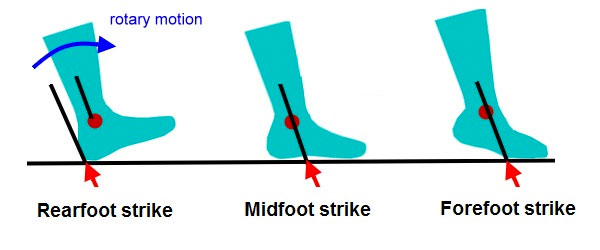Today’s footwear is far more advanced than in the 70’s, but a shoe is only as good as the stride it takes. Understanding your stride is vital to improving your mile time and recovery rates and reducing injuries.
To strike the heel, or not to strike the heel?
As you pound your feet across the pavement, try to focus on how your feet are landing: Heels first? Totally flat footed? Toes first?
The way your foot strikes the ground has a huge impact on running performance and injury rates.
Runners generally fall into three categories: heel strikers, forefoot strikers, or midfoot strikers. When you are looking to prevent injury and improve performance, the ideal thing to do is AVOID heel striking.

Injury Prevention
Heel striking increases ground reaction forces, creating larger amounts of stress forces every stride you take. Want a visual? Imagine landing from a jump solely on your heels (get it) versus a soft landing using the ankle and forefoot to absorb initial forces. Long story short, if you heel strike then you are taking much higher amounts of stressful forces than someone with a forefoot strike.
Efficiency
Heel striking is an efficient walking pattern, which is why heel strikers often look like they are shuffling or walking. An interesting fact about runners and fatigue levels, is that when forefoot runners fatigue they move towards a midfoot striking pattern, and when midfoot strikers fatigue they move to a heel striking pattern. Which brings the big question, is the heel strike an easier pattern to adopt when energy resources are low or is it a weaker running pattern.
Changing Strike Patterns
If you’re a heel striker, don’t worry! You can learn to forefoot strike, but you must walk before you can run. The most common injuries can be easily prevented with proper form and preparation prior to running.
- Many people suggest easing into the forefoot strike: start with walking on you forefoot, building up to a set of 100 meters. Then try running up a short hill.
- RELAX: allow your body to relax as you are adjusting your stride.
- Take it slow and commit to it: As you are moving from heel to forefront, don’t be concerned with the distance or speed that you are running. The last thing you want to do is overdo it and cause an injury that will keep you from running at all!
Work With a Professional
One of the best things you can do in ANY sport if you are trying to improve performance and efficiency is work with a professional.
A few years back a middle-distance runner came in with hip problems and a heel strike pattern. He was pretty fast regardless, running a 5:30 mile. He was able to trim almost a full minute off that time moving to a forefoot strike, also he was running pain free and recovering faster.
Veritas Performance Training knows how to safely and effectively improve your form. Work with us today to evaluate your current striking pattern. For more information or to schedule an evaluation, contact us today!

